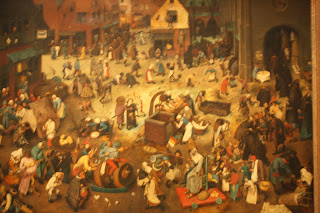 Once we actually started our tour of the museum and the art, something became very clear very quickly. Catholic and Protestant art are as different as the two religions themselves. This is something that Kathy had asked us to look at but even without this prompting the differences between the selections of the two styles were so glaring that I do not think anyone could have missed them.
Once we actually started our tour of the museum and the art, something became very clear very quickly. Catholic and Protestant art are as different as the two religions themselves. This is something that Kathy had asked us to look at but even without this prompting the differences between the selections of the two styles were so glaring that I do not think anyone could have missed them.  Catholic art seemed to be all about bold colors, huge paintings, and depictions of the divine while Protestant art seemed to focus more on earthly subjects and use dark and drab colors. I think that the two artists from the Kunsthistorische who best illustrate the extremity of these styles are Peter Paul Rubens and Rembrandt.
Catholic art seemed to be all about bold colors, huge paintings, and depictions of the divine while Protestant art seemed to focus more on earthly subjects and use dark and drab colors. I think that the two artists from the Kunsthistorische who best illustrate the extremity of these styles are Peter Paul Rubens and Rembrandt. Peter Paul Rubens was so in demand that he had a workshop who helped him with his often gigantic pieces. His subjects appear to be mostly great lords, saints, or other divine beings. Although the figures are painting extremely well and most are anatomically correct, there appears to be very little else about these paintings that could be considered realistic. Like Catholic churches, these paintings seem to be more about praising God through lavish art and bold, beautiful colors than about actually depicting scenes from everyday life.
Rembrandt on the other hand occupies the total opposite side of the artistic spectrum. His paintings all tend to be created with extremely dark colors and they almost all portray scenes or portraits that I can only describe as overly realistic. That is not a necessarily bad or a good thing, but it can be a very depressing thing when one looks at the self portraits Rembrandt did. It is very clear that his earthy living has paid a heavy toll on him both physically and mentally. Instead of lifting the viewer up and reminding them of heaven, Rembrandt, and Protestant artistis in general, ground the viewer.
The differences between Protestant and Catholic art seem to accurately illustrate some of the core differences between the two faiths with Catholics often being much more interested in the saints and the divine and Protestants being interested in less fantastic and lavish religious practices.
I just wanted to include some pictures of other paintings I found interesting:




No comments:
Post a Comment